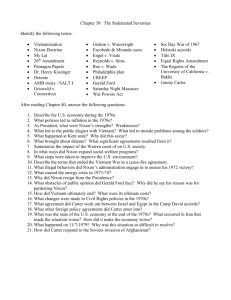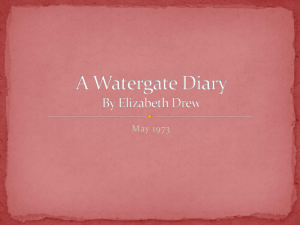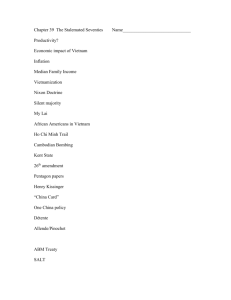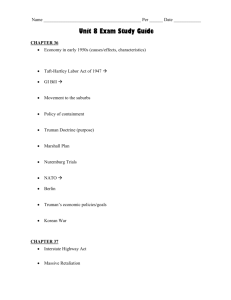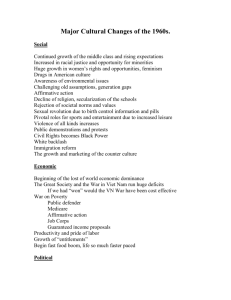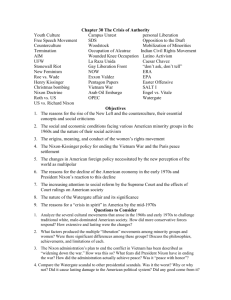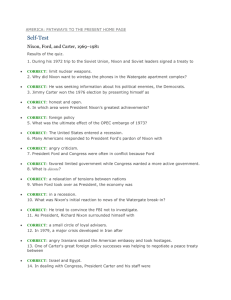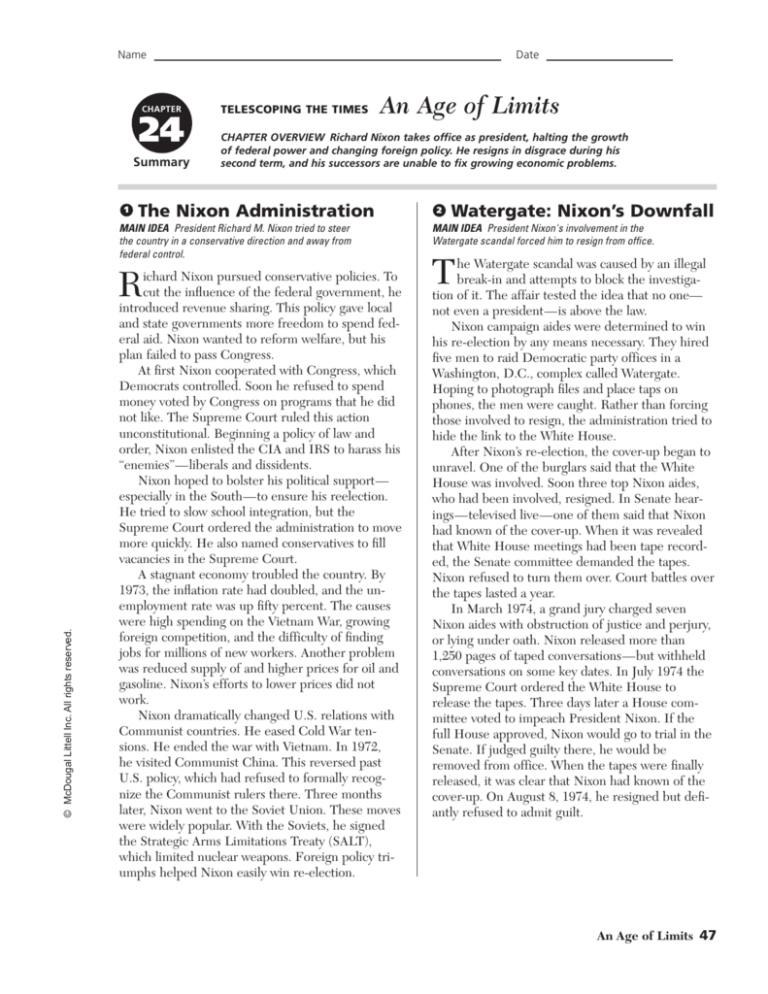
Name
CHAPTER
24
Summary
1
Date
TELESCOPING THE TIMES
An Age of Limits
CHAPTER OVERVIEW Richard Nixon takes office as president, halting the growth
of federal power and changing foreign policy. He resigns in disgrace during his
second term, and his successors are unable to fix growing economic problems.
The Nixon Administration
MAIN IDEA President Richard M. Nixon tried to steer
the country in a conservative direction and away from
federal control.
© McDougal Littell Inc. All rights reserved.
R
ichard Nixon pursued conservative policies. To
cut the influence of the federal government, he
introduced revenue sharing. This policy gave local
and state governments more freedom to spend federal aid. Nixon wanted to reform welfare, but his
plan failed to pass Congress.
At first Nixon cooperated with Congress, which
Democrats controlled. Soon he refused to spend
money voted by Congress on programs that he did
not like. The Supreme Court ruled this action
unconstitutional. Beginning a policy of law and
order, Nixon enlisted the CIA and IRS to harass his
“enemies”—liberals and dissidents.
Nixon hoped to bolster his political support—
especially in the South—to ensure his reelection.
He tried to slow school integration, but the
Supreme Court ordered the administration to move
more quickly. He also named conservatives to fill
vacancies in the Supreme Court.
A stagnant economy troubled the country. By
1973, the inflation rate had doubled, and the unemployment rate was up fifty percent. The causes
were high spending on the Vietnam War, growing
foreign competition, and the difficulty of finding
jobs for millions of new workers. Another problem
was reduced supply of and higher prices for oil and
gasoline. Nixon’s efforts to lower prices did not
work.
Nixon dramatically changed U.S. relations with
Communist countries. He eased Cold War tensions. He ended the war with Vietnam. In 1972,
he visited Communist China. This reversed past
U.S. policy, which had refused to formally recognize the Communist rulers there. Three months
later, Nixon went to the Soviet Union. These moves
were widely popular. With the Soviets, he signed
the Strategic Arms Limitations Treaty (SALT),
which limited nuclear weapons. Foreign policy triumphs helped Nixon easily win re-election.
2
Watergate: Nixon’s Downfall
MAIN IDEA President Nixon's involvement in the
Watergate scandal forced him to resign from office.
T
he Watergate scandal was caused by an illegal
break-in and attempts to block the investigation of it. The affair tested the idea that no one—
not even a president—is above the law.
Nixon campaign aides were determined to win
his re-election by any means necessary. They hired
five men to raid Democratic party offices in a
Washington, D.C., complex called Watergate.
Hoping to photograph files and place taps on
phones, the men were caught. Rather than forcing
those involved to resign, the administration tried to
hide the link to the White House.
After Nixon’s re-election, the cover-up began to
unravel. One of the burglars said that the White
House was involved. Soon three top Nixon aides,
who had been involved, resigned. In Senate hearings—televised live—one of them said that Nixon
had known of the cover-up. When it was revealed
that White House meetings had been tape recorded, the Senate committee demanded the tapes.
Nixon refused to turn them over. Court battles over
the tapes lasted a year.
In March 1974, a grand jury charged seven
Nixon aides with obstruction of justice and perjury,
or lying under oath. Nixon released more than
1,250 pages of taped conversations—but withheld
conversations on some key dates. In July 1974 the
Supreme Court ordered the White House to
release the tapes. Three days later a House committee voted to impeach President Nixon. If the
full House approved, Nixon would go to trial in the
Senate. If judged guilty there, he would be
removed from office. When the tapes were finally
released, it was clear that Nixon had known of the
cover-up. On August 8, 1974, he resigned but defiantly refused to admit guilt.
An Age of Limits 47
Name
The Ford and Carter Years
MAIN IDEA The Ford and Carter administrations
attempted to remedy the nation's worst economic crisis
in decades.
S
ucceeding Richard Nixon was Gerald Ford.
Though likable and honest, Ford lost support
when he pardoned Nixon. Ford faced a poor economy, with prices rising 6 to 11 percent a year
fueled by sharp increases in the cost of foreign oil.
His first program to halt inflation by encouraging
energy conservation failed. When he pushed for
high interest rates, a recession was the result.
Ford ran for election in 1976 against Democrat
Jimmy Carter. An outsider not involved in
Washington politics, Carter promised he would never
lie to Americans. He won a close election at a time of
cynicism towards the Washington establishment.
Worried about the nation’s reliance on imported
oil, Carter believed that energy policy should be his
top priority. The National Energy Act placed a tax
on cars that had low gas mileage, removed price
controls on domestic oil and natural gas, and funded research for new sources of energy. In 1979,
however, another shutdown of oil imports plus
steep oil price hikes crippled the economy. Carter
tried voluntary price freezes and spending cuts but
could not halt inflation.
The economic problems of the 1970s were
caused in part by changes in the economy. Greater
automation meant fewer manufacturing jobs.
Foreign competition cost American jobs too. Many
companies were leaving the industrialized northeast
for the South and West to find lower energy costs
and less costly labor.
In foreign policy, Carter tried to follow moral
principles. He cut aid to countries that violated the
rights of their people. He agreed to treaties with
Panama that promised to give control of the
Panama Canal to that country. He signed a new
nuclear arms treaty—called SALT II—with the
Soviets. But when the Soviets invaded Afghanistan,
relations cooled and the treaty died.
Carter arranged a peace agreement between
Israel and Egypt. Just months later, Muslim fundamentalists seized power in Iran. Angered at U.S.
support for the former ruler, the shah, they took
control of the American embassy in Iran’s capital
and held 52 Americans hostage. Despite efforts,
48 Unit 7, Chapter 24
Carter could not obtain release of the hostages.
They were held for 444 days, freed just minutes
after Ronald Reagan was inaugurated on January
20, 1981, as the new president.
4
Environmental Activism
MAIN IDEA During the 1970s, Americans strengthened
their efforts to address the nation's environmental
activism.
C
oncern for the environment was spurred by
the 1962 book Silent Spring. That book argued
that pesticides were poisoning food and killing
birds and fish. Awakened to this threat, the environmental movement took off on April 22, 1970—
the first celebration of Earth Day. The day was
marked by events aimed at raising awareness of
environmental problems.
President Nixon created the Environmental
Protection Agency. He also signed the Clean Air
Act, which required industry to take steps to
reduce pollution from smokestacks and automobiles. Other new laws to protect the environment
were passed as well.
When vast oil reserves were discovered in
Alaska, oil companies built a huge pipeline to carry
the oil to the sea. Nixon and Carter took steps to
ensure that this industrial development did not
harm Alaska’s natural resources.
Nuclear energy became the focus of a growing
debate. Some felt it was safe and clean. Others
feared nuclear accidents. A 1979 accident caused a
Pennsylvania nuclear reactor to release radiation
into the air. Afterwards, the government strengthened safety measures for nuclear plants.
The debate over the environment continues
today. Some Americans oppose environmental laws.
They argue that such laws protect wildlife at the
expense of people and limit economic growth.
Review
1. How did Nixon ease Cold War tensions?
2. Why was Watergate a constitutional crisis?
3. How did Ford and Carter try to fix economic
problems, and why didn’t their plans work?
4. What differing needs are the focus of the debate
over environmental laws?
© McDougal Littell Inc. All rights reserved.
3
An Age of Limits continued



